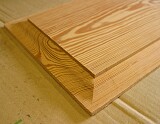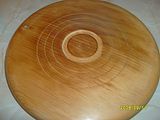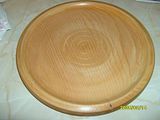You are using an out of date browser. It may not display this or other websites correctly.
You should upgrade or use an alternative browser.
You should upgrade or use an alternative browser.
Pitch Pine Platter
- Thread starter loz
- Start date

Help Support UKworkshop.co.uk:
This site may earn a commission from merchant affiliate
links, including eBay, Amazon, and others.
Hi Loz.
Good attempt with a very difficult wood to finish well.
By the looks of the top surface you have used a scraper to finish, before sanding. It has pulled the end grain around the inner edge, generally with any pine timber you must use a VERY sharp gouge, and no scapers.
Also you need to spend a lot more time on your sanding procedure. DON'T move on to another grit until the one your using has removed all marks from the one preceding. Then on these soft timbers, stop the lathe between each grit and hand sand with the grain. It really helps to remove the sanding circles.
An very commendable attempt, but as I said you didn't do yourself any favours by using Pine. It is not a easy wood to work well.
Hope some of these tips help.
Also the timber doesn't look like Pitch Pine to me, but it may be the photo. Normally the grain in Pitch is a lot darker, almost a dark chestnut colour against a orangey background. Of course the final check is always cutting this wood, it has a fantastic aroma.
Good attempt with a very difficult wood to finish well.
By the looks of the top surface you have used a scraper to finish, before sanding. It has pulled the end grain around the inner edge, generally with any pine timber you must use a VERY sharp gouge, and no scapers.
Also you need to spend a lot more time on your sanding procedure. DON'T move on to another grit until the one your using has removed all marks from the one preceding. Then on these soft timbers, stop the lathe between each grit and hand sand with the grain. It really helps to remove the sanding circles.
An very commendable attempt, but as I said you didn't do yourself any favours by using Pine. It is not a easy wood to work well.
Hope some of these tips help.
Also the timber doesn't look like Pitch Pine to me, but it may be the photo. Normally the grain in Pitch is a lot darker, almost a dark chestnut colour against a orangey background. Of course the final check is always cutting this wood, it has a fantastic aroma.
Bodrighy
Established Member
I presume that the wood had been cut some time ago or you'd be cursing it as you cleaned your lathe & tools off if it is pitch pine. As Tam said. lovely smell but as sticky as glue IME.
When you finish pine, seal it between grades. I found that this , as well as going to a high grade will give you a good finish. also don't press hard if you are doing it by hand. I have a bowl I did in pine that has a ribbed effect because I pressed too hard and the grain is of different densities. Really hard to get a good result like this platter (at least fro me )
)
Pete
When you finish pine, seal it between grades. I found that this , as well as going to a high grade will give you a good finish. also don't press hard if you are doing it by hand. I have a bowl I did in pine that has a ribbed effect because I pressed too hard and the grain is of different densities. Really hard to get a good result like this platter (at least fro me
Pete
Paul.J
Established Member
Nice looking platter Loz  though the finish does let it down a bit
though the finish does let it down a bit 
Do you have the lathe running at a slowish speed when sanding :?:
Do you have the lathe running at a slowish speed when sanding :?:
Paul.J":2c5y5xh1 said:Nice looking platter Lozthough the finish does let it down a bit

Do you have the lathe running at a slowish speed when sanding :?:
If im honest i'll say on the base, i ran at lowest speed, and took 10 - 15 minutes on it, then after reversing, and doing the top, i got impatient, and sped up the lathe to 2nd slowest speed ( fixed 4 speed lathe ) .
I was just eager to get a finish on it, and i know i know i need to sand slow, and go thru the grits !!!
I'm also going to get some sealer, and follow Petes advice above.
I might remount it and cut back the finish on the top, and sand again
Paul.J
Established Member
I know what you mean Loz.Finishing isn't my strongest point,i too get impatient :roll: but you still should get a better finish before applying any sealer.
Do you move the paper back and forth across the work piece as you sand:?:
Do you move the paper back and forth across the work piece as you sand:?:

£24.99
Facemoon Reusable Masks,Safety Masks,Dual Filter Masks, Paint, Dust, Epoxy Resin, Construction, Welding, Sanding, Woodworking, Chemical Reusable Gas Masks
ShenZHEN CIRY MINGYANG LITIAN ELECTRONIC ECOMMERCE

£12.50 (£1,250.00 / kg)
£14.45 (£1,445.00 / kg)
JSP M632 FFP3moulded Disposable Dustmask (Box of 10) One Size suitable for Construction, DIY, Industrial, Sanding, dust protection 99 Percent particle filtration Conforms and Complies to EN 149
Amazon.co.uk

£238.91
£360.17
Trend Portable Benchtop Router Table with Robust Construction for Workshop & Site Use, 240V, CRT/MK3
Amazon.co.uk

£17.99 (£1.80 / count)
£27.44 (£2.74 / count)
3M 8822 Disposable-fine dust mask FFP2 (10-pack)
Amazon.co.uk
Are you sure it was actually pitch pine? You said it was quite light - the stuff I've used is at least as dense as oak, and has a very pronounced figuring, which doesn't show in your pics.
True PP is a bit of a pig to turn, 'cos it's quite brittle but it smells lovely and if you can get it sanded right, takes a nice finish
True PP is a bit of a pig to turn, 'cos it's quite brittle but it smells lovely and if you can get it sanded right, takes a nice finish
DavidE
Established Member
Just to echo a few other posters I'm not entirely sure that is Pitch Pine by it's colouring. I've worked with a lot over the last year that is at least 130 years old and it is still as sticky as ever - a lovely distinct smell too.
This is more what I have found PP to look like.

(Sorry it's not round)
One side of your platter is maybe close to this and does have some grain markings I have seen in PP. What does your workshop smell like?
If you do resand it (which I think would be worthwile) make sure you don't get it too hot otherwise you might get some checking of the end grain (like Yew)
Hope this helps
David
This is more what I have found PP to look like.

(Sorry it's not round)
One side of your platter is maybe close to this and does have some grain markings I have seen in PP. What does your workshop smell like?
If you do resand it (which I think would be worthwile) make sure you don't get it too hot otherwise you might get some checking of the end grain (like Yew)
Hope this helps
David
pete honeyman
Established Member
I've tried turning a few softwoods, pine and larch particularly, but it's rarely been worth the time taken. A few of mine have also cracked later, though the grain and colouring can be very strong.
I've had a couple of different types of Pitch Pine - the first, similar to that shown was a tight grained, prone to splinter but easily turned and good finishing wood.
The second was a pig - very hard, very resinous wide grained with lots of huge 'live' knots.
Both were very smelly, but completely different and both were from old mills and about 150 tears old.
Chris.
The second was a pig - very hard, very resinous wide grained with lots of huge 'live' knots.
Both were very smelly, but completely different and both were from old mills and about 150 tears old.
Chris.
Hi. Thought I had been lucky when I was given the end of a church pew to play with. Wrong! Total nightmare! I still have about 6 bits left that I could rescue from woodworm and rot that I've put to one side for a rainy day. Its a combination of hard and soft at the same time? As correctly mentioned above, too much pressure and you get a strange ripple effect. And is there any other wood that creates tear out so easy??? And smell? Nope, strangely it smells of a damp old church I thought!....not a whiff of a pine forest! So, well done with your platter I say!
Pitch pine has very distinct contrast between the summer and winter wood giving a decidedly finely striped look, it is also very dense and so heavy too, it has a very pleasant resinous smell, but leaves resin all over the place, even when it is well seasoned, it's resinous nature is what made it so suitable for shipbuilding. The wood in the platter is pretty much not Pitch Pine, could be fir or another pine species, but not PP.
Similar threads
- Replies
- 39
- Views
- 2K





























